1. Les Paul (1915-2009)
His innovative talents extended into his playing style, including licks, trills, chording sequences, fretting techniques and timing, which set him apart from his contemporaries and inspired many guitarists of the present day. He recorded with his wife Mary Ford in the 1950s, and they sold millions of records. Among his many honors, Paul is one of a handful of artists with a permanent, stand-alone exhibit in the Rock and Roll Hall of Fame.
2. Jimi Hendrix (1942-1970)
Hendrix, as well as his friend Eric Clapton, popularized use of the wah-wah pedal in mainstream rock which he often used to deliver an exaggerated pitch in his solos, particularly with high bends, complex guitar playing, and use of legato. As a record producer, Hendrix also broke new ground in using the recording studio as an extension of his musical ideas. He was one of the first to experiment with stereophonic phasing effects for rock recording. Hendrix won many of the most prestigious rock music awards in his lifetime, and has been posthumously awarded many more, including being inducted into the Rock and Roll Hall of Fame in 1992.
3. Chet Atkins (1924-2001)
Atkins produced records for Perry Como, Elvis Presley, the Everly Brothers, Eddy Arnold, Don Gibson, Jim Reeves, Jerry Reed, Skeeter Davis, Connie Smith, Waylon Jennings and others. Atkins is notable for his broad influence. His love for numerous styles of music can be traced from his early recordings all the way to modern rock stylings of many notable guitar players. Among many honors, Atkins received 14 Grammy Awards as well as the Grammy Lifetime Achievement Award, nine Country Music Association Instrumentalist of the Year awards, and was inducted into the Country Music Hall of Fame.
4. Tommy Tedesco (1930-1997)
Tommy can be heard on almost any TV show recorded between 1960-1980 including Twilight Zone, Mickey Mouse Club, Bonanza, Green Acres, Mash, as well as movies like The Deer Hunter, Field Of Dreams, Jaws, and The Godfather. He also was a music educator, wrote books and a long running colum in Guitar Player Magazine. Although Tedesco was primarily a guitar player, he also played the mandolin, ukulele, and the sitar as well as 28 other stringed instruments (though he played all of them in guitar tuning).
5. Charlie Christian (1916-1942)
John Hammond and George T. Simon called Christian the best improvisational talent of the swing era. In the liner notes to the 1972 Columbia album Solo Flight: The Genius of Charlie Christian, Gene Lees writes that “many critics and musicians consider that Christian was one of the founding fathers of bebop, or if not that, at least a precursor to it”. Christian’s influence reached beyond jazz and swing — in 1990 he was inducted into the Rock and Roll Hall of Fame.
6. Tampa Red (1904-1981)
Tampa Red was known as “The Man With The Gold Guitar“, and, into the 1930s, he was billed as “The Guitar Wizard”. The National guitar he used was a gold-plated tricone, which was found in Illinois in the 1990s by music-shop owner and guitarist Randy Clemens and later sold to the “Experience Music Project” in Seattle Tampa Red was known as “The Man With The Gold Guitar“, and, into the 1930s, he was billed as “The Guitar Wizard”.
7. Chuck Berry (1926)
Berry was among the first musicians to be inducted into the Rock and Roll Hall of Fame on its opening in 1986, with the comment that he “laid the groundwork for not only a rock and roll sound but a rock and roll stance.” Berry is included in several Rolling Stone “Greatest of All Time” lists, including being ranked fifth on their 2004 list of the 100 Greatest Artists of All Time.
